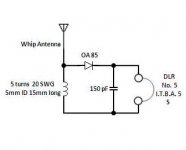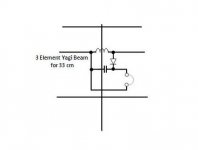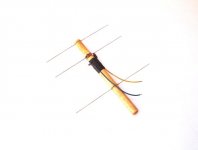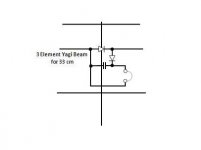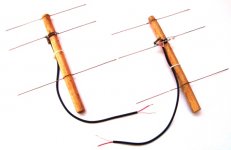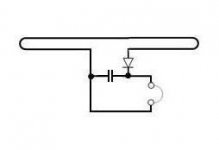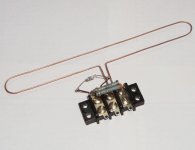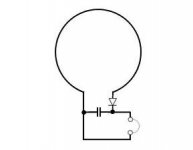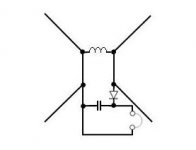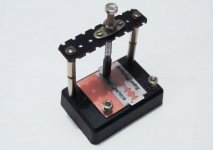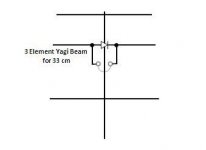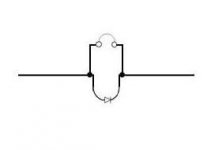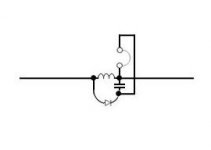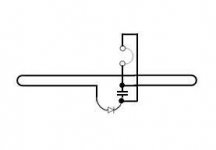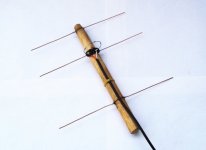Attachments
Last edited:
I don't know anything about the availability of Amplitude Modulated signals in your part of the world in the UHF spectrum.
Here in the US, 33cm is a valid amateur radio band, and I can produce 500 watts of SSB on 33cm. I don't believe 33cm is open to amateur radio outside North America. I built a system for EME on 33cm a few years ago, but interference from nearby cell towers blocked my receiver.
Modern cell equipment uses a complex digital modulation scheme (CDMA and LTE) which caries both an amplitude and phase component. This modulation can be detected, but not demodulated with an AM only receiver. There are digital cell phone transmitters in the US at 896 MHz, but most of them are around 2 GHz.
At least in the US much of the aircraft to ground transmission is still pure AM. Civilian aircraft can be heard around 120 MHz, and Military aircraft around 128 MHz and 240 MHz. The worldwide aircraft bands are 118 to 137 MHz, and 225 to 400 MHz (Military, and often spread spectrum).
If you live near a flight path, or an airport these transmissions may be detectable, and audible, but a different antenna will be needed.
Note, some germanium diodes may have limited usefulness at 900 MHz. Try a common 1N914 or 1N4148 silicon switching diode. Some of these work far beyond their intended application in terms of frequency.
Here in the US, 33cm is a valid amateur radio band, and I can produce 500 watts of SSB on 33cm. I don't believe 33cm is open to amateur radio outside North America. I built a system for EME on 33cm a few years ago, but interference from nearby cell towers blocked my receiver.
Modern cell equipment uses a complex digital modulation scheme (CDMA and LTE) which caries both an amplitude and phase component. This modulation can be detected, but not demodulated with an AM only receiver. There are digital cell phone transmitters in the US at 896 MHz, but most of them are around 2 GHz.
At least in the US much of the aircraft to ground transmission is still pure AM. Civilian aircraft can be heard around 120 MHz, and Military aircraft around 128 MHz and 240 MHz. The worldwide aircraft bands are 118 to 137 MHz, and 225 to 400 MHz (Military, and often spread spectrum).
If you live near a flight path, or an airport these transmissions may be detectable, and audible, but a different antenna will be needed.
Note, some germanium diodes may have limited usefulness at 900 MHz. Try a common 1N914 or 1N4148 silicon switching diode. Some of these work far beyond their intended application in terms of frequency.
RFID systems also operate around 900 MHz. Their signal strength is restricted to fairly low values by regulations, but they are found in surprising places. Of course you expect them in warehouses and storage facilities for factories and retail stores but they are also used to track luggage on airlines and freight in trucks; monitor employee attendance and activities in offices, factories, hospitals and schools; and to time athletic events. Like mobile phones, the modulation schemes are rather complex and unrecognizable when listening on headphones.
Linear Technology's LTC-5505 IC is a rather sophisticated UHF detector circuit, though it requires a power supply. The Avago (formerly Hewlett-Packard) HSMS-28xx line of Schottky diodes are intended for use at UHF, and readily available at low cost from common distributors like Mouser and Digi-Key. I believe NXP (Philips) has a line of comparable products.
Dale
Linear Technology's LTC-5505 IC is a rather sophisticated UHF detector circuit, though it requires a power supply. The Avago (formerly Hewlett-Packard) HSMS-28xx line of Schottky diodes are intended for use at UHF, and readily available at low cost from common distributors like Mouser and Digi-Key. I believe NXP (Philips) has a line of comparable products.
Dale
You made a modern version of a 100 years old design  , known in WW1 and WW2 as Foxhole/Trench/Concentration Camp Radio, depending on where you were actually "living":
, known in WW1 and WW2 as Foxhole/Trench/Concentration Camp Radio, depending on where you were actually "living":

No diodes available, so detector was either a bobby pin touching a rusty shaving blade, or a graphite pencil lead, also touchbing said blade, the rustier the better.

of course a real diode will make it work better .

No diodes available, so detector was either a bobby pin touching a rusty shaving blade, or a graphite pencil lead, also touchbing said blade, the rustier the better.
An externally hosted image should be here but it was not working when we last tested it.

of course a real diode will make it work better .
Hi Fahey,
Here's my modern version of the foxhole radio!
Amateur Radio : Foxhole Radio detector variants
Many thanks.
Regards,
Nandu.
Here's my modern version of the foxhole radio!
Amateur Radio : Foxhole Radio detector variants
Many thanks.
Regards,
Nandu.
Attachments
Who here is old enough to have adjusted the cat's whisker on their galena crystal?
me -- but it was a curiousity. I still have my copy of "A Boys First Book of Electricity" by Morgan.
I used a crystal set to listen to the Cleveland Indians.
As little electronics experience as I have, that's actually one. How I put it together with no guidance is a mystery to me now but at some time between 8 and 10 or so years old I had one of those single high z earphones stuffed into my ear and marveled at how poking away at a chunk of "some sort of metalic cubey sumthin" embedded in a lead surround got me a crystal clear radio station. 'Trouble was, that station wasn't very interesting for a kid my age so using it didn't last very long. I also came by a one sided bakelite headset that I recall sounded pretty great, though I suspect now I'd liken it to a tomato can on a string.
I'd completely forgotten about it all. Thanks for the reminder. I might even still have that little contraption. . . . . . . . in a box . . . . . . . . . somewhere.
I'd completely forgotten about it all. Thanks for the reminder. I might even still have that little contraption. . . . . . . . in a box . . . . . . . . . somewhere.
The latest update!
A second Yagi Beam was then rigged up, with another diode providing the return path for the audio, instead of the coil.
The signal strength was not as good. During trials, a chance shorting of the second diode gave a considerable increase in signal strength.
The diode and capacitor were hence discarded. Performance of this single-diode UHF crystal radio is quite good.
Regards,
Nandu.
A second Yagi Beam was then rigged up, with another diode providing the return path for the audio, instead of the coil.
The signal strength was not as good. During trials, a chance shorting of the second diode gave a considerable increase in signal strength.
The diode and capacitor were hence discarded. Performance of this single-diode UHF crystal radio is quite good.
Regards,
Nandu.
Attachments
Some thoughts on UHF Crystal Radios
Diode capacitance
Low capacitance diodes are a must for UHF crystal radios.
It follows that they are to be so wired that the capacitance between their leads is kept to a minimum.
This does not imply that the leads are to be cut to minimum length. In fact longer leads facilitate antenna-diode impedance matching.
Antenna-diode impedance matching
Stub matching is a must for maximizing the signal strength.
Long diode leads may be used to form the stub.
A diode length of λ/4 gives a proper match.
A circular stub is best for minimum capacitance between the leads.
Regards,
Nandu.
http://nandusthoughts.blogspot.in/2016/02/some-thoughts-on-uhf-crystal-radios.html
Diode capacitance
Low capacitance diodes are a must for UHF crystal radios.
It follows that they are to be so wired that the capacitance between their leads is kept to a minimum.
This does not imply that the leads are to be cut to minimum length. In fact longer leads facilitate antenna-diode impedance matching.
Antenna-diode impedance matching
Stub matching is a must for maximizing the signal strength.
Long diode leads may be used to form the stub.
A diode length of λ/4 gives a proper match.
A circular stub is best for minimum capacitance between the leads.
Regards,
Nandu.
http://nandusthoughts.blogspot.in/2016/02/some-thoughts-on-uhf-crystal-radios.html
Attachments
Last edited:
- Status
- This old topic is closed. If you want to reopen this topic, contact a moderator using the "Report Post" button.
- Home
- General Interest
- Everything Else
- UHF Crystal Radio
